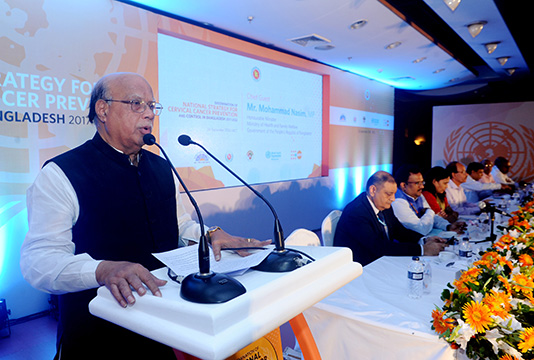DHAKA, Sept 24, 2018 (BSS) – Health and Family Welfare Minister Mohammed
Nasim today stressed the need for maintaining political stability for the
development of any country, including Bangladesh.
“We need political stability…No nation can make progress without
becoming a stable and peaceful country,” he said.
He was speaking as the chief guest at a programme titled, ‘A coordinated
Approach to Eradicate Cervical Cancer: Dissemination of the National Strategy
For prevention and Control in Bangladesh’ at Bangabandhu International
Convention Centre (BICC) in the city.
Health Ministry with the help of World Health Organisation (WHO) and UNFPA
organised the event.
Director General of Directorate General of Health Services (DGHS)
Professor Dr Abul Kalam Azad presided over the progamme while Vice Chancellor
(VC) of Bangabandhu Sheikh Mujib Medical University (BSMMU) Professor Dr
Kanak Kanti Barua, Pro-VC(Research and Development) M Shahidullah Sikder,
representatives from WHO, UNFPA were present, among others.
Nasim, also the Presidium Member of Awami League, said, “The country is
politically stable now, there is no strike, no blockade … For this
steadiness we are now able to make exemplary success at every sector,
including health.”
“There is no alternative to Prime Minister Sheikh Hasina to lead Awami
League government for maintaining peace and prosperity of the country,” he
added.
Nasim expressed his gratefulness to the people of the country to stand
beside the government led by the Prime Minister Sheikh Hasina for building a
prosperous country.
“None but Awami League government can make overall development and
maintain peace across the country,” he added. Nasim said the health ministry
is committed in preventing cervical cancer in the country.
DGHS DG Dr Azad said, “The national strategy for Bangladesh has been
designed with the goal to reduce the incidence, prevalence and mortality from
cervical cancer through a coordinated and refined approach.”
Cervical cancer is the second most common cause of female cancer mortality
worldwide. It is a type of cancer that occurs in the cells of the cervix –
the lower part of the uterus that connects to the vagina. Various strains of
the human Papilloma Virus (HPV), a sexually transmitted infection, play a
role in causing most cervical cancer.



